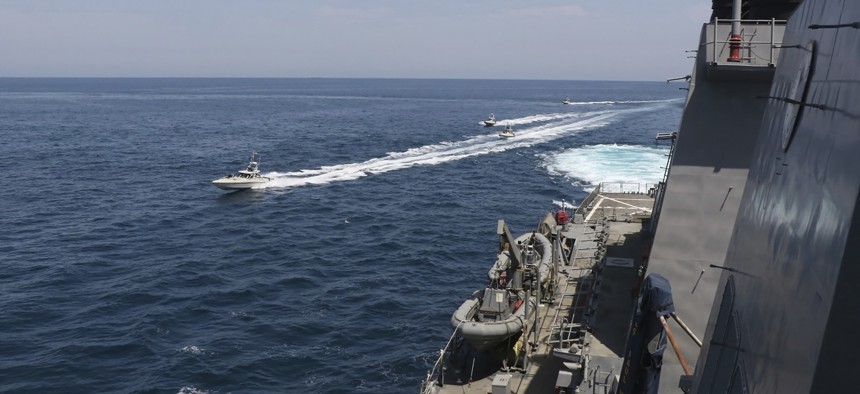
In this Wednesday, April 15, 2020, photo made available by U.S. Navy, Iranian Revolutionary Guard vessels sail close to U.S. military ships in the Persian Gulf near Kuwait. US Navy
Will the US Navy Sink Iranian Fast Boats in the Gulf? Maybe, Maybe Not
It may be time to formalize how orders are passed from the White House to the military.
U.S. military officials praised their commander-in-chief for some early-Wednesday tough talk about Iran — but would not say whether it constituted a change in policy or rules of engagement.
Tweeted President Trump a bit after 8 a.m. Washington time: “I have instructed the United States Navy to shoot down and destroy any and all Iranian gunboats if they harass our ships at sea.”
As with his past tweets, it was not immediately clear whether this had actually happened or was a lawful order, and reporters asked the vice chairman of the Joint Chiefs to clarify at a press conference later in the morning.
“What the president says sends a great message to Iran,” said Air Force Gen. John Hyten, the military’s No. 2 officer. “That's perfect. We know how to translate that into our rules of engagement.
“We don't talk about rules of engagement in public, but they're based on the inherent right of self defense,” Hyten continued. “They're based on hostile intent and hostile act. That's all we need in order to take the right action.”
Trump’s tweet came a week after armed Iran Revolutionary Guard boats passed unusually close to four U.S. Navy and two Coast Guard ships in the Persian Gulf. Video from April 15 shows the small boats speeding around the larger vessels. At one point, a U.S. ship sounds its horn five times. Iranian go-fast boats have harassed Navy and commercial ships in the Gulf for several decades.
Both Hyten and Deputy Defense Secretary David Norquist refused to say whether Trump’s tweet amounted to a policy change in the way the Navy responds to small armed boats interfering with larger warships.
“I like that the president warned an adversary. That's what he's doing. He's providing a warning,” Hyten said. “If you want, if you want to go down that path, we will come and we will come large. So don't go down that path. That is what he's saying. He's saying it in clear, uncertain terms.”
Added Norquist: “I think it was a very useful thing that he put out.”
Yet the essential nature of Trump’s words — order or not? Policy change or not? Escalation or not? — remains unclear. As Charles J. Dunlap Jr., a former Air Force deputy judge advocate general, noted in November: “Orders from the commander-in-chief ought not need interpreting.”
Dunlap referenced a solution proposed in 2018: “Given the increasing ubiquity of social media, today it may be time for Congress, working with the Executive Branch, to formalize how the respective branches of government will communicate with each other. In questions of peace and war especially, there is no room for uncertainty,” wrote Sai Kolluru, a scholar at Duke’s Center on Law, Ethics and National Security.




